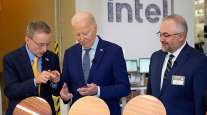Associated Press
CHIPS Act Will Ramp Up Production, but Report Cites Costs

[Stay on top of transportation news: Get TTNews in your inbox.]
WASHINGTON — A sweeping 2022 law, touted by President Joe Biden as a way to revive U.S. manufacturing of semiconductors and reduce the country’s reliance on foreign-made computer chips, will “sharply increase production’’ of semiconductors in the United States. But it will do so at a high cost and might not deliver the best bang for the buck, concludes a report out Jan. 15 by an economic think tank in Washington.
Researchers at the Peterson Institute for International Economics calculated that the $280 billion CHIPS and Science Act will create about 93,000 construction jobs as chip factories go up in the United States and 43,000 permanent jobs once they’re in operation. But the government subsidies behind the expected chip manufacturing boom mean that each job created will cost taxpayers about $185,000 a year — twice the average annual salary of U.S. semiconductor employees, the Peterson report found.
“More production might not provide the best security for the money,’’ wrote researchers Gary Hufbauer and Megan Hogan.
The Peterson report notes that in passing the CHIPS Act Congress “did not consider alternative ways’’ of spending billions of dollars to ensure the U.S. had adequate chip supplies. Other options could have included creating a chip stockpile run by the Federal Emergency Management Agency or providing financial incentives for U.S. chip users and foreign chip producers to keep bigger inventories of semiconductors in the United States.
NEW: A preliminary review of the CHIPS Act shows it seems likely to sharply boost production of advanced semiconductors in the US, reducing the risk of future shortages but leaving America reliant on imported chips. Jobs created will come at notable costs.https://t.co/pSwEtMLMV6 — Peterson Institute (@PIIE) January 15, 2025
Biden touted and Congress passed the CHIPS Act after semiconductor supplies ran short following COVID-19 lockdowns. The shortages disrupted production of automobiles and other products. The Biden administration also viewed ramping up made-in-America chip production as a national security issue because it would reduce U.S. reliance on foreign imports of chips, which are used by the military as well as private companies.
A study by the Boston Consulting Group and the Semiconductor Industry Association has found that America’s share of world chip production capacity, measured by volume and not dollar value, fell from 37% in 1990 to just 10% in 2022.
Truck Parking Club's Evan Shelley discusses how innovative platforms are turning available space into opportunities for reserved parking. Tune in above or by going to RoadSigns.ttnews.com.
Policymakers are alarmed that U.S. industry depends heavily on chips manufactured in Taiwan, a supply that could be threatened if China launches military strikes intended to force the autonomous island to reunite politically with the Chinese mainland. The giant Taiwan Semiconductor Manufacturing Co., which supplies chips to Apple and Qualcomm, among others, is investing heavily in chip plants in Arizona.
The CHIPS Act also aims to boost the U.S. share of the world’s advanced chips to 20% by 2030 from none today. But the Peterson report argued that such a leap would require additional government subsidies and overcoming shortages of skilled labor and electricity. It also noted that South Korea and Taiwan are offering their own chipmaking giants generous tax credits to protect their lead in the market. Asking whether the U.S. can meet that 20% goal, the Peterson researchers conclude: “Maybe.’’
Want more news? Listen to today's daily briefing above or go here for more info
It’s unclear whether the incoming Trump administration will scrap or make changes to the CHIPS Act. During the election campaign, President-elect Donald Trump had argued that tariffs on foreign chips — not subsidies to encourage U.S. production — would have done more to bring semiconductor plants to the United States.
But the Peterson researchers noted that in the past European Union tariffs had failed to revive chip production in Europe. “There is no compelling reason why a comparable tariff would prove more successful for the United States,’’ they wrote.





